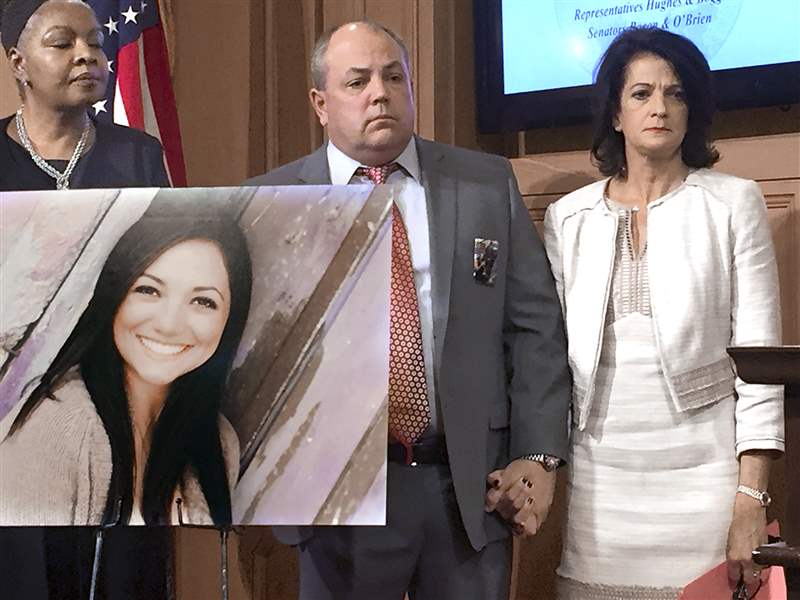
Concerns raised about price tag of proposed Tokes law
11/28/2017
Toby Tokes, center, and his wife, Lisa Lisa McCrary-Tokes, stand next to a photo of their murdered daughter, Reagan. They are joined on the left by state Rep. Bernadine Kennedy Kent (D., Columbus).
THE BLADE/JIM PROVANCE
Buy This Image
COLUMBUS — The American Civil Liberties Union of Ohio testified Tuesday that there hasn’t been enough discussion on the potential costs of implementing sentencing and parole reforms under a bill named for murder victim Reagan Tokes.
The 21-year-old former Monclova Township woman was three months shy of graduating from Ohio State University when she was kidnapped and raped as she left her job at a Columbus restaurant on Feb. 8.
She was shot and her body left in a Grove City park. Her alleged killer, Brian Lee Golsby, 29, awaits trial and could face the death penalty.
A registered sex offender, he’d been recently released from prison after serving time for attempted rape, was living in a halfway house, and was equipped with a GPS ankle monitoring bracelet. Despite these precautions, he is believed to have committed several robberies in the days prior to Ms. Tokes’ murder.
His electronic ankle monitor was later used to retrace his steps, but it was not monitored in real time so no red flags were raised until his DNA was allegedly found on a cigarette in Ms. Tokes’ car.
House Bill 365, sponsored by Reps. Jim Hughes (R., Columbus) and Kristin Boggs (D., Columbus), would reinstate sentence ranges with minimums and maximums for specific violent crimes, using the threat of additional time to convince inmates to behave and improve themselves while behind bars.
It would also require the hiring of additional parole officers to hike supervision and mandate restrictions on those with GPS ankle bracelets so that real-time alerts would go out when curfew or other violations occur.
Gary Daniels, chief lobbyist for ACLU Ohio, told the House Criminal Justice Committee that the organization does not oppose the bill and actually likes some of its provisions.
But he raised concerns about the lack of discussion regarding costs of hiring more parole officers, creating more temporary housing for newly released inmates, ensuring there are enough GPS monitoring devices to go around, and building a new database for the Department of Rehabilitation and Correction.
“If these reforms are to benefit Ohio, they must be adequately funded…,” Mr. Daniels said. “HB 365 remains silent on whether there will be sufficient GPS devices for those who will be paroled, and what happens if a device is not available when they are ready for release.”
He suggested an inmate might end up spending more time in prison simply because a GPS device is not available.
He also raised concerns about the broad discretion the bill would give DRC in deciding whose behavior warrants longer prison stays. He suggested a study to ensure that discretion does not lead to disparities based on race, class, and geography.
The indefinite sentencing provisions would move Ohio in the opposite direction from where it has headed since passing the so-called “truth in sentencing” law in 1996. That law emphasized finite sentencing, eliminating discretionary minimums and maximums.
Sara Andrews, executive director of the Ohio Criminal Sentencing Commission, said the 1996 law has not played out as intended as prison population continued to rise until recently. The population hovers around 50,000 inmates, well above the system’s designed capacity.
“We are far removed from truth in sentencing as we know it already…,” she said. “Truth in sentencing has been eroded.”
Contact Jim Provance at: jprovance@theblade.com or 614-221-0496.